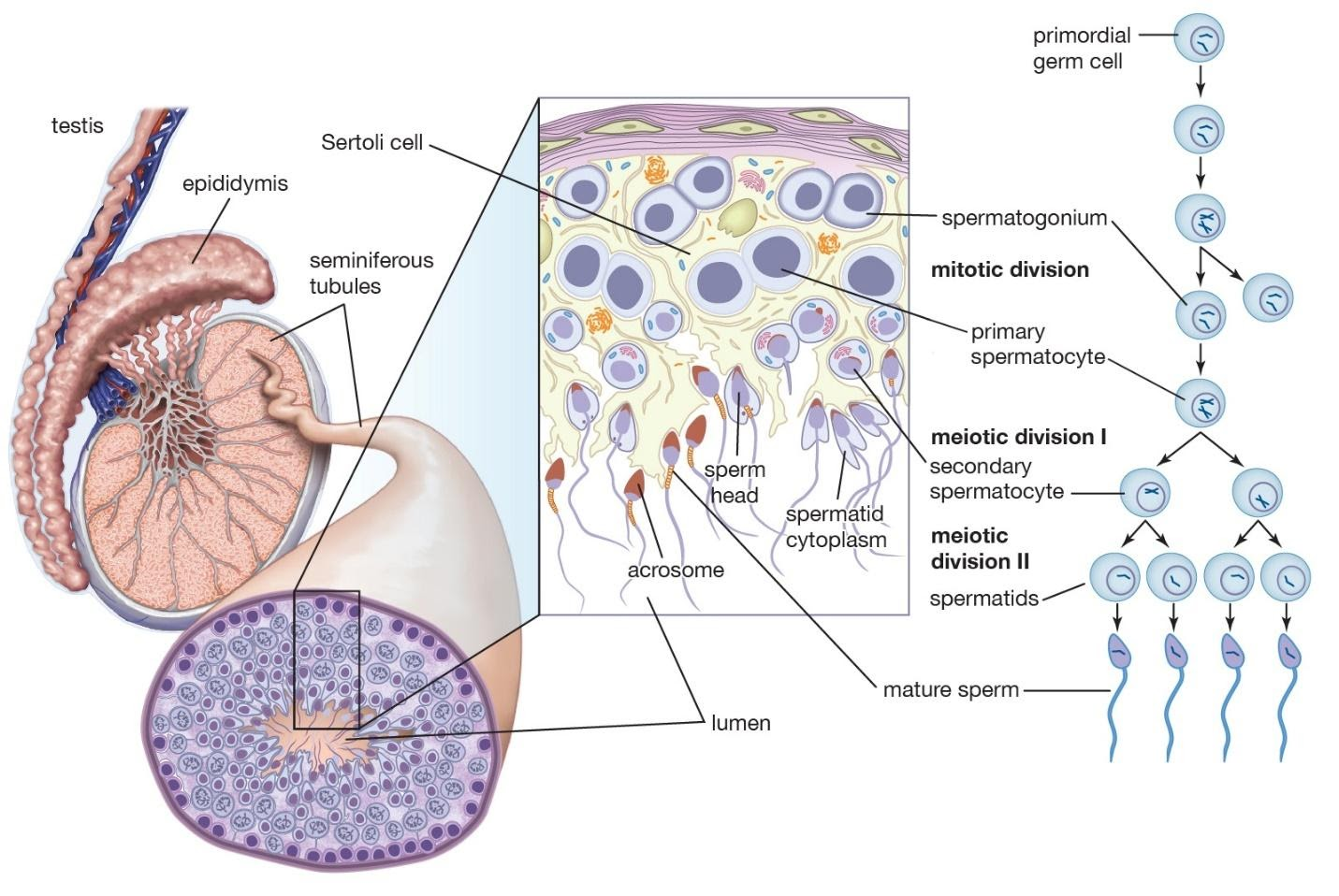
What is the structure of the seminiferous tubule?
Answer
400.5k+ views
Hint: The testes include seminiferous tubules, which are the site of meiosis and the subsequent formation of male gametes, namely spermatozoa. Sertoli cells, which are tall, columnar cells that line the tubule's epithelium, are a type of sustentacular cell that lines the tubule. Spermatogenic cells, which differentiate into sperm cells during meiosis, are found in between the Sertoli cells. Sertoli cells are responsible for nourishing the sperm cells as they mature. They release androgen-binding protein, a protein that binds to testosterone and raises its concentration inside the seminiferous tubules.
Complete answer:
The male reproductive organs are the testes. There are around two hundred fifty testicular lobules or compartments in each testis. Seminiferous tubules generate sperm, and each testicular lobule includes about two seminiferous tubules. They make up about ninety percent of the testicular volume.
A seminiferous tubule is a coiled structure. The outer tunica propria, basal lamina, and stratified epithelial layer are the three layers of tissues that make up the wall of seminiferous tubules. Two types of cells make up the epithelium:
Male germ cells, also known as spermatogenic cells, are cells that produce sperm.
Sertoli cells are nutrient-carrying cells.
Differentiating spermatogenic cells at different stages of spermatogenesis can be seen in an ordered form in the seminiferous tubules.
Leydig cells are present in the interstitial areas outside the seminiferous tubules. Androgens are synthesised and secreted by them.

STRUCTURE OF SEMINIFEROUS TUBULE
Note:
The testes include seminiferous tubules. They contain sperm-producing male germ cells. Sertoli cells can also be found in the seminiferous tubules, which feed the germ cells.
In the seminiferous tubules, spermatogenesis (the process of creating spermatozoa) takes place. The DNA of spermatogenic cells in the seminiferous tubules is damaged during spermatogenesis by reactive oxygen species and other environmental factors. DNA repair methods safeguard the genetic integrity of spermatogenic cells. Infertility can be caused by deficiencies in the enzymes involved in these repair mechanisms.
Complete answer:
The male reproductive organs are the testes. There are around two hundred fifty testicular lobules or compartments in each testis. Seminiferous tubules generate sperm, and each testicular lobule includes about two seminiferous tubules. They make up about ninety percent of the testicular volume.
A seminiferous tubule is a coiled structure. The outer tunica propria, basal lamina, and stratified epithelial layer are the three layers of tissues that make up the wall of seminiferous tubules. Two types of cells make up the epithelium:
Male germ cells, also known as spermatogenic cells, are cells that produce sperm.
Sertoli cells are nutrient-carrying cells.
Differentiating spermatogenic cells at different stages of spermatogenesis can be seen in an ordered form in the seminiferous tubules.
Leydig cells are present in the interstitial areas outside the seminiferous tubules. Androgens are synthesised and secreted by them.

STRUCTURE OF SEMINIFEROUS TUBULE
Note:
The testes include seminiferous tubules. They contain sperm-producing male germ cells. Sertoli cells can also be found in the seminiferous tubules, which feed the germ cells.
In the seminiferous tubules, spermatogenesis (the process of creating spermatozoa) takes place. The DNA of spermatogenic cells in the seminiferous tubules is damaged during spermatogenesis by reactive oxygen species and other environmental factors. DNA repair methods safeguard the genetic integrity of spermatogenic cells. Infertility can be caused by deficiencies in the enzymes involved in these repair mechanisms.
Recently Updated Pages
Master Class 9 General Knowledge: Engaging Questions & Answers for Success

Master Class 9 English: Engaging Questions & Answers for Success

Master Class 9 Science: Engaging Questions & Answers for Success

Master Class 9 Social Science: Engaging Questions & Answers for Success

Master Class 9 Maths: Engaging Questions & Answers for Success

Class 9 Question and Answer - Your Ultimate Solutions Guide

Trending doubts
Types of lever in which effort is in between fulcrum class 12 physics CBSE

Which are the Top 10 Largest Countries of the World?

A two input XOR Gate produces a high output only when class 12 physics CBSE

What is a transformer Explain the principle construction class 12 physics CBSE

Give five points to show the significance of varia class 12 biology CBSE

Draw a labelled sketch of the human eye class 12 physics CBSE




